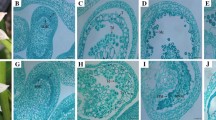Summary
Genetic male sterility has been described in the pea (Pisum sativum L.), but no comprehensive effort has been made to study the phenomenon. A preceding companion paper reported the inheritance, allelism and linkage relations of thirteen male sterile mutants obtained from seed mutagen treatments. In the present study, the same male sterile mutants were investigated cytologically to determine the cause of sterility. Normal microsporogenesis and microgametogenesis was compared to that of the mutants. The ms-2, ms-3, and ms-4 mutants exhibited meiotic abnormalities similar to those described by Gottschalk and colleagues except that ms-3 had a high degree of female sterility. Chromosome clumping and spindle abnormalities leading to formation of coenocytic microspores and degeneration were characteristic of ms-2 and ms-4. The ms-2 and ms-4 mutants were previously found to be allelic, and were nearly identical cytologically in the present study. The ms-3 mutant exhibited a lack of chromosome condensation in meiosis I, and a lack of spindle formation in both meiotic divisions. Two mutations (ms-6 and ms-10) affected meiosis, with univalents at metaphase, and asynchronous divisions during meiosis II. Microspores of ms-6 completely degenerated whereas those of ms-10 showed some development. Sticky chromosomes, bridges and fragments, tripolar spindles, and lack of a second division were characteristic of ms-10. The ms-10 mutant also showed reduced female fertility. Two male steriles (ms-5 and ms-9) had abnormalities associated with premature degeneration of the tapetum. Three others (ms-7, ms-8, and ms-11) aborted pollen during meicrogametogenesis. Pollen grains of ms-11 had thinner walls than normal and lacked sculptured exine. The ms-10 mutant, and those affecting microgametogenesis (ms-5, ms-7, ms-8, ms-9, and ms-11) produced some stainable and viable pollen.
Similar content being viewed by others
References
Albertsen, M.C. & R.L. Phillips, 1981. Developmental cytology of 13 genetic male sterile loci in maize. Can. J. Genet. Cytol. 23: 195–208.
Beeks, R.M., 1955. Improvements in the squash technique for plant chromosomes. El Aliso 3: 131–133.
Berlyn, G.P. & J.O. Miksche, 1976. Botanical Microtechnique and Cytochemistry. Iowa State Univ. Press, Ames, Iowa (USA).
Biddle, J.A., 1979. Anther and pollen development in garden pea and cultivated lentil. Can. J. Bot. 57: 1883–1900.
Cooper, G.O., 1938. Cytological investigations of Pisum sativum. Bot. Gaz. 99: 584–591.
Dowrick, G.J., 1953. The chromosomes of Chrysanthemum, III: Meiosis in C. atratum. Heredity 7: 219–226.
Frankel, R. & E. Galun, 1977. Pollination Mechanisms in Reproduction and Plant Breeding. Springer-Verlag, New York (USA).
Gerlach, D., 1969. A rapid safranin-crystal violet-light green staining sequence for paraffin sections of plant materials. Stain Tech. 44: 210–211.
Gottschalk, W., 1971. Our present knowledge on the genetic control of microsporogenesis in Pisum. Pisum Newsl 3: 9–10.
Gottschalk, W. & S.R. Baquar, 1972. Breakdown of meiosis in a mutant of Pisum sativum. Cytobiologie 5: 42–50.
Gottschalk, W. & A. Jahn, 1964. Cytogenetische untersuchungen an desynaptischen und männlich-sterilen mutanten von Pisum. Z. Vererbungsl. 95: 150–166.
Gottschalk, W. & M.L.H. Kaul, 1974. The genetic control of microsporogenesis in higher plants. Nucleus 17: 133–166.
Gottschalk, W. & H.D. Klein, 1976. The influence of mutated genes on sporogenesis. Theor. Appl. Genet. 48: 23–34.
Heslop-Harrison, J., 1976. The adaptive significance of the exine. p. 27–37. In: J.K. Ferguson & J. Muller (Eds) The Evolutionary Significance of the Exine. Linn. Soc. Symp. Series 1. Academic Press, New York (USA).
Iwanaga, M. & S.J. Peloquin, 1979. Synaptic mutant affecting only megasporogenesis in potato. J. Hered. 70: 385–389.
Jain, S.K., 1959. Male sterility in flowering plants. Biblio. Genet. 18: 167–272.
Klasterska, I. & C. Ramel, 1981. Peculiarities in PMC meiosis of Pisum sativum. Theor. Appl. Genet. 59: 297–302.
Klein, H.D., 1969. Male sterility in Pisum. Nucleus 12: 167–172.
Klein, H.D., 1971. Eine Pisum-mutante mit zahlreichen meiotischen störungen. Cytologia 36: 15–25.
Klein, H.D. & S.R. Baquar, 1972. Genetically controlled chromosome breakage and reunions in the meiosis. Chromosoma 37: 223–231.
Koduru, P.R.K. & M.K. Rao, 1981. Cytogenetics of synaptic mutants in higher plants. Theor. Appl. Genet. 59: 197–214.
Laser, K.D. & N.R. Lersten, 1976. Anatomy and cytology of microsporogenesis in cytoplasmic male sterile angiosperms. Bot. Rev. 38: 425–454.
Lifschytz, E. & G.F. Meyer, 1977. Characterization of male meiotic-sterile mutations in Drosophila melanogaster. Chromosoma 4: 371–392.
Love, A., 1944. Cytogenetic studies on Rumex subgenus Acetocella. Hereditas 30: 1–136.
Mascarenhas, J.P., 1975. The biochemistry of angiosperm pollen development. Bot. Rev. 41: 259–314.
McClintock, B., 1951. Chromosome organization and gene expression. Cold. Spr. Harb. Symp. Quant. Biol. 16: 13.
Mok, D.W.S. & S.J. Peloquin, 1975. Three mechanisms of 2n pollen formation in diploid potatoes. Can. J. Genet. Cytol. 17: 217–225.
Myers, J.R. & E.T. Gritton, 1988. Genetic male sterility in the pea (Pisum sativum L.): I. Inheritance, allelism and linkage. Euphytica 38: 165–174.
Rick, C.M., 1948. Genetics and development of 9 male-sterile tomato mutants. Hilgardia 18: 599–633.
Sass, J.E., 1958. Botanical microtechnique. Iowa State Univ. Press, Ames, Iowa.
Satina, S. & A.F. Blakeslee, 1935. Cytological effects of a gene in Datura which causes dyad formation in sporogenesis. Bot. Gaz. 96: 521–532.
Tilquin, J.P., K. de Brouwer & F. Horvat, 1984. Unusual cytological patterns in microsporogenesis in a cultivar of Fuchsia 1. Multiple spindle. Theor. Appl. Genet. 67: 413–417.
Author information
Authors and Affiliations
Rights and permissions
About this article
Cite this article
Myers, J.R., Gritton, E.T. & Struckmeyer, B.E. Genetic male sterility in the pea (Pisum sativum L.). Euphytica 63, 245–256 (1992). https://doi.org/10.1007/BF00024551
Received:
Accepted:
Issue Date:
DOI: https://doi.org/10.1007/BF00024551




